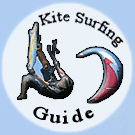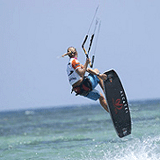Safety Guidelines
These are the guidelines to follow when kitesurfing:
1. Launching & Landing & safety Systems:
2. DO NOT HOOK IN TO THE CHICKEN LOOP NOR SHACKLE IN before launching or landing. Before launching or landing, use the trim strap to depower the kite. Should you be using a "spin leash" or "swivel bar", try using the system which lets you to launch and land unhooked.
3. Never surf if you don’t have a dead-man safety release system a dead-man safety release system on you which will allow you at any time to disable the kite at any moment. You can do that simply by not holding onto the control devices and the advantage is that this is a system that is said to work even if you are unconscious are unconscious.
Some of the kiters nowadays use a manual safety release system when detaching themselves from the kite. They attach themselves to the kite (chicken loop or chicken loop line). Nevertheless, some kiters have experienced some time ago some serious or even fatal accidents by using this type of devices, as they do not work when the kiter is unconscious and cannot react in time given a dangerous situation. The system only works when they are conscious and able to react very fast. You also have to be sure that the safety release system is well tested, as it will be described later on. To sum up, this manual safety release system is one that must be handled more carefully than others and my advice is that you use it only when you are out in open water.
The dead-man safety systems do not work anymore if you are hooked-in. This is why you must unhook when you are near hard objects or should you want to launch, land the kite.
4. A kiter must never launch , ride or jump upwind of people or hard objects and must always keep a minimum distance of 1.5 line-length from any of them.
5. Before launching a kite, check the set up , the kite and the lines.
6. It is not a good idea to have a non-kitesurfer assist you while landing or launching a kite. This is from a safety point of view, as it is never advised to ask a non-kitesurfer help you to launch and land the kite.
7. The safety leash can never be permanently attached to a wrist or harness. In order to do this, Velcro tapes or any quick release mechanism can be used.
8. If the kite is large and the wind is over 8 knots, never hook in your harness on land.
9. You must have built muscles in order to easily unhook everytime. So, get doing lots of pull up by pulling your body toward the kite!
10. Where, When, Wear & How:
11. A place in the near vecinity of power lines or airports is never a good place to kitesurf.
12. You must not kitesurf on a stormy wheather or before, during, after a thunder storm.
13. Offshore wind is not proper for kitesurfing.
14. Always keep an eye on a beach downwind from where you start kitesurfing.
15. Crowded water is never suited for a beginner in the kitesurfing business. So quickly go out to an un-crowded area or in the open water.
16. A novice must never kitesurf in wind stronger than 20 knots, and given wind of over 30 knots, nor must an experienced kitesurfer.
17. A life jacket or impact vest is compulsory during kitesurfing.
18. A helmet is also required during kitesurfing.
19. Be extra careful so that other people do not get the chance to tangle up with the flying lines, as flying lines can get cut if the kite is flying. Avoid that by never wrapping flying lines around your hand and not flying your kite over other people.


